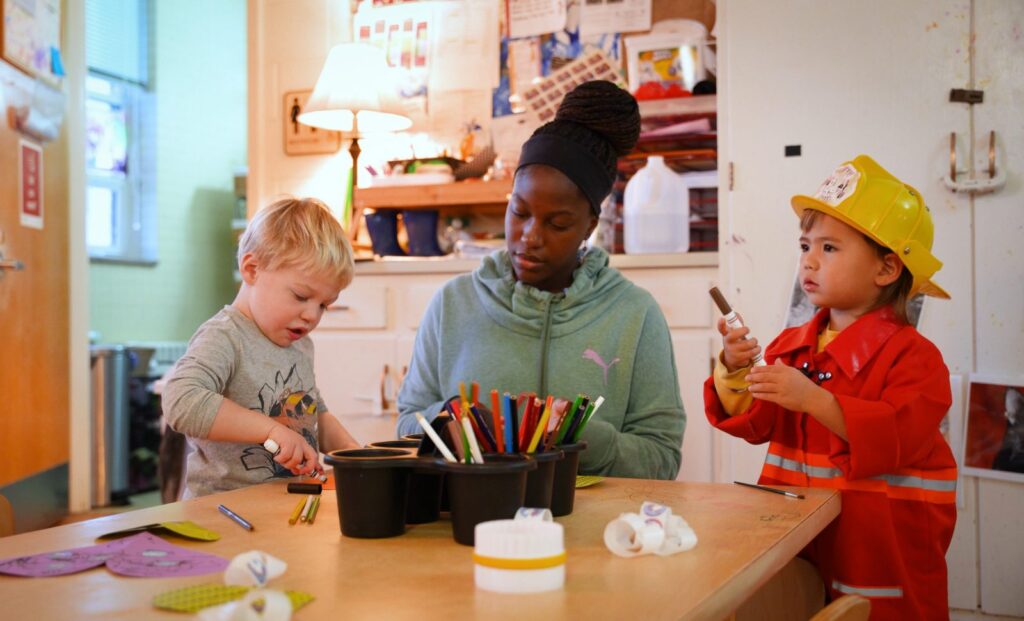With his stuffed fox toy in tow, 2-year-old Bennett eagerly bounced through the classroom, inspecting it as he went along.
Art projects adorned the walls inside of Virginia Tech’s Child Development Center for Research and Learning. The sound of laughter echoed through the room as children learned and played.
Bennett’s first order of business? Ensuring “Foxy” was well-rested for the day ahead.
Using a mix of sign language and verbalization, he indicated he needed to put his furry friend down for a nap before he gently placed him in a small crib. Virginia Tech student Margaret Buxton signed back as she spoke to him.
Since beginning her field study placement at the center, Buxton, a childhood pre-education development major with a minor in disability studies, has made it her mission to learn American Sign Language to better communicate with Bennett.
See Video HERE
“Having someone at the center who is able to sign with Bennett has made a huge impact on his life,” Sheree Andrews said, adding that Bennett often comes home from school signing new words. “It’s day and night when you’re learning a new language or second language. It’s important to have full immersion.”
Bennett is deaf and is able to hear with the aid of cochlear implants, small electronic devices that stimulate the auditory nerve. But his parents want him to learn sign language so that he is capable of full communication when he isn’t wearing the implants and so that he will feel more connected to others in the deaf community.
They, along with Bennett’s 6-year-old sister, are learning sign language. Buxton’s interactions with Bennett make for a smooth transition from home to the classroom, his parents said. Along with helping Bennett with his auditory and speaking skills, the center has embraced the family’s desire for him to learn American Sign Language “with open arms,” David Andrews said.
“It’s just been really special,” he said. “It’s one reason that we love the center so much.”

Alexa Gardner, assistant director and senior instructor in the Child Development Center, said most of the center’s field study students are human development majors who want to work with children and families. But many still are deciding what career path to take. The students can receive three to six credits for their field study work, which they complete under the mentorship of full-time teachers.
“It’s more and more crucial to think about those early years of development,” Gardner said, adding that students often want to work with older children before starting at the center. “When they get here, they see all the development that occurs from birth to 5 and just how rapid and critical brain development is in those early years and how it really affects outcomes for the rest of the child’s life.”
Gardner said Buxton has a skill for connecting with children one-on-one and determining their individual development needs.
“It’s beautiful to watch that unfold for her,” Gardner said. “She sees the benefits for her own career aspirations, certainly, and how it’s helping her in those vital skills. But the love she has for the children and the families, and just how she values that, is what’s been really special.”

The center provides invaluable opportunities for undergraduate students seeking classroom experience – something Buxton said can be difficult to find in rural communities. Part of her inspiration to help children succeed stems from her own struggle with dyslexia, she said, noting that she has always been “fascinated with language and the ways it is taught.”
Buxton is taking a class that provides an introductory coursework around American Sign Language (ASL). Meeting Bennett gave her the opportunity be more hands on in her approach to learning the language — a skill she hopes will be helpful to other children in her future career.
“It just became a perfect storm that I could learn sign language and then practice with Bennett,” she said.
Buxton, who will graduate in May, said once she is a teacher, ensuring her classroom is accessible will be her top priority.
Bennett’s parents, who both work at Virginia Tech, said learning a new language as an adult is challenging. They are taking classes online and have tutors to guide them through the process.
“One of the hardest things is ASL is its own language, and we’re learning that it’s not just the signs, it’s your body expressions, it’s your facial expressions,” Sheree Andrews said. “There’s so much that goes into it. The grammar is very different. And so, we’re always trying to stay ahead.”
At home, they said Bennett is a hands-on kid who likes drawing, playing with toy cars and trains, and loves his sister. There, Bennett has another “Foxy.” The center staff bought him an identical one for school when they realized how much the toy meant to him – another example of how deeply the center cares for him.
“We’ve been a part of the Virginia Tech community and the greater Blacksburg-Christiansburg community for over 10 years now, and it’s been a really wonderful community to be a part of,” Sheree Andrews said. “Virginia Tech has so many resources for families and for employees, and we are very excited to take advantage of them.”
The center’s mission is to be a model preschool program for local, state, and national early childhood communities in teaching, learning, and research. It has four classrooms with children ranging from 4 weeks to 5 years old. Learn more about the center.
Giving Day donations to the center can be made from noon Feb. 21 to noon Feb. 22.
By Kelsey Bartlett

